Over the years, one of the things that has surprised me is just how differently different players perceive my “allegiance” to certain kinds of Magic strategies. For some players, I am viewed as a paragon of control; for others, they view me as a kind of champion of rogue decks; still others attribute me to red decks in general (or Burn or Ponza in specific).
All of these things are true, in a way. One of the things I discovered in talking Magic at the two Planes Talkers events (the most recent at GP Chicago and the first at GP Minneapolis is that the biggest common thread between my decks is that I like to make my opponents feel miserable. Making someone feel dread is something that I felt like I accomplished by dropping my favorite creature into play on turn one in old Extended:
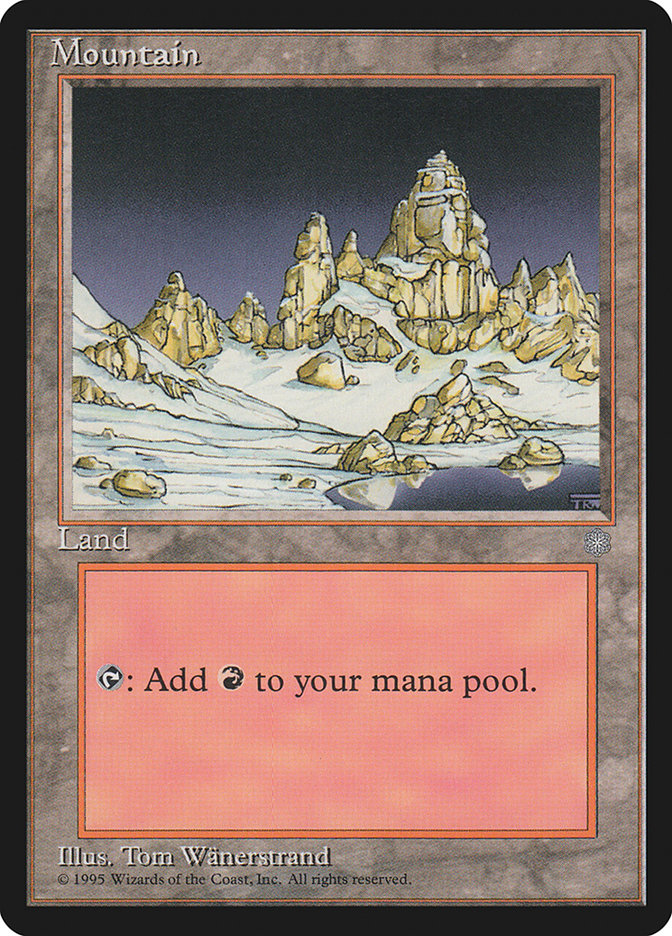
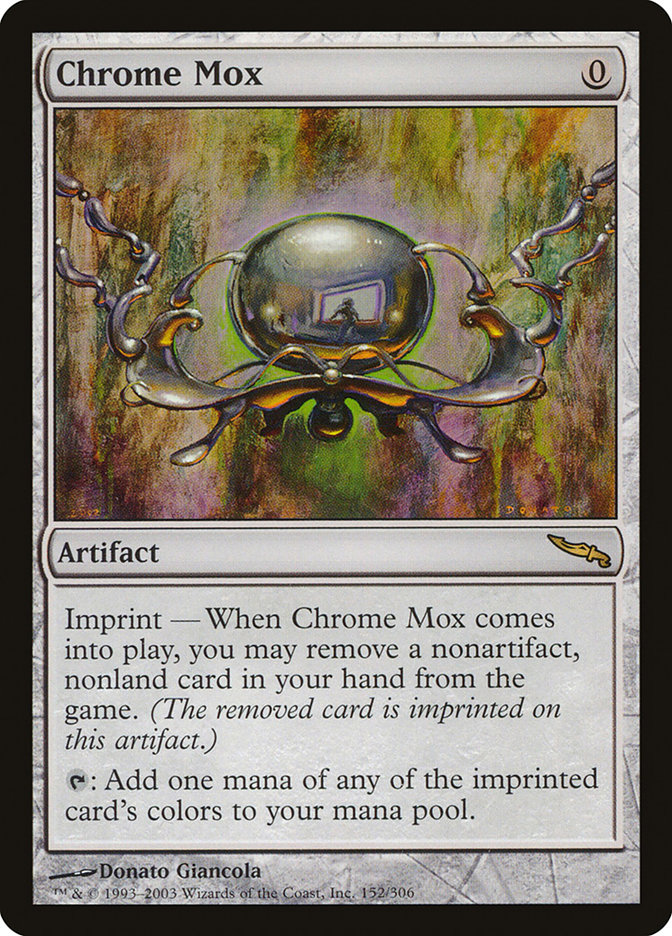
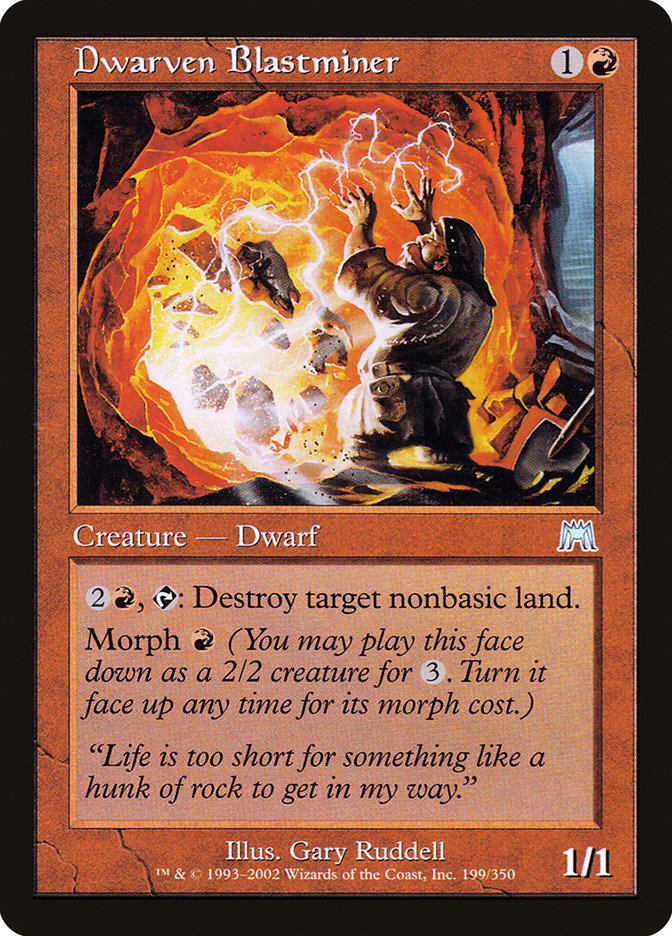
 My first hugely successful deck was the first Counter-Oath deck, back in 1998. People weren’t yet used to what could happen when an Oath of Druids hit play, especially backed up by counterspells. (For a fun, 3,000-word account of this deck, you should check out the original post on it, circa 1998.) Again, though, this is often not a deck that people generally enjoy playing against.
My first hugely successful deck was the first Counter-Oath deck, back in 1998. People weren’t yet used to what could happen when an Oath of Druids hit play, especially backed up by counterspells. (For a fun, 3,000-word account of this deck, you should check out the original post on it, circa 1998.) Again, though, this is often not a deck that people generally enjoy playing against.
Burn often inspires similar grief in people. It’s so polarizing, both for the people who play it and for the people who play against it – you don’t often find someone who has a middle-of-the-road opinion of burn, who has played it a few times themselves and who never minds playing against it no matter how awful the matchup may be for them. Burn inspires Patrick Sullivan to get the Twitter handle “@BasicMountain” and inspires untold numbers of people to rage-quit on MTGO or scream at their opponent as they check “drop” on the match slip. There are no lukewarm opinions about burn, and I love that fact. Like, for example, this exchange on Twitter:
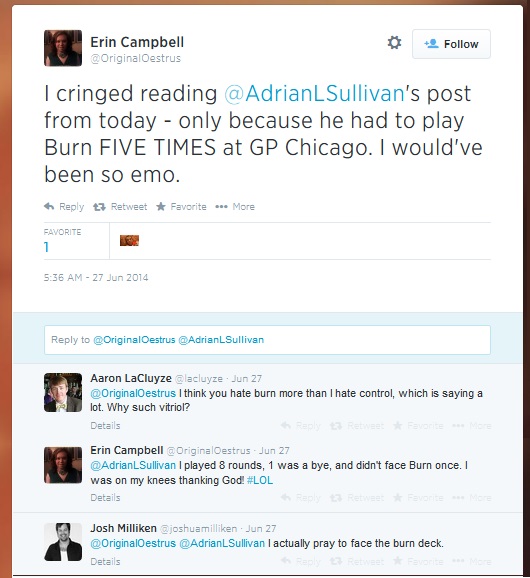
I think a part of what makes Burn so frustrating for people is that it is easy to perceive the matchup as being mindless. If you followed my GP Chicago play-by-play on Facebook, you know that in my five matches against Burn, I won each match, but I lost three of the games against them. Importantly, nearly all of those games I won I was within a thin sliver of death by fire. While not all of my opponents played Burn particularly well, most of them played very well, and I continued to see a number of Burn players at the top tables all the way through until the end of the Swiss rounds.
The way that Burn approaches the game of Magic in many matchups is on an angle where there is a minimum of interaction. A traditional beatdown deck takes out your life in little chunks during the attack phase. Another deck can interact with this strategy a huge number of ways. Just dropping your own creatures or having a little bit of creature removal can put you into the same realm. A deck going directly for the throat, your life total, dodges most of the vectors of interaction that people make plans for.
It’s this factor that I think people find so demoralizing: not having the means to interact with what your opponent is doing to. The idea that “life matters” is the heart of one of the major theories in Magic, and I’m proud to have pioneered it. I first articulated this concept way back in 1999 on a trip to Grand Prix Memphis with Mike Flores, Zvi Mowshowitz, Mike Pustilnik and Rob Hahn. The idea had been floating in my head for some time, but I explained the theory behind it to those luminaries on that trip. Flores would name my concept “The Philosophy of Fire” (a good primer for it is here, and a longer take is here), and since then, the theory has been used (and misused) endlessly in tournament Magic.
This has always given me a very soft spot for Burn decks in general. I still remember the first semi-mindblowing Burn deck that I ever saw. It ran Demonic Consultation, Ball Lightning, Fireblast, Fork, and Goblin Grenade, along with something like eight crappy Goblins (just enough to power Goblin Grenade and Consultation). I don’t know that the deck was actually good or not, but what it was doing felt bonkers.
These days, Burn is still one of my favorite decks. I make it in every format. In the prep for Pro Tour Rise of the Eldrazi (San Juan), I worked with what is now Team Channel Fireball Pantheon, and while the Burn deck I made for that format wasn’t good enough to warrant consideration, I still found a way to make it work, largely on the power of attacking the format sideways.
In current Standard, we have two Burn decks that have recently done very well, though the deck has been floating at the top for a while now.
Creatures (8)
Lands (23)
Spells (29)

Creatures (8)
Lands (23)
Spells (29)

These decks are incredibly similar, which is unsurprising given the power of some cards and the narrowness of the archetype, but they also have some interesting lessons to offer.
One of the most important lessons is the minimal amount of cards that are actually low-impact spells to end the game. Each player runs six such cards. Tyler running two Chained to the Rocks, two Shock, and two Wild Guess where Igor runs three Chained to the Rocks and three Shocks. Shock isn’t a particularly great burn spell, in terms of the kind of damage that it generates (Magma Jet may be less damage per mana, but it also helps find more damage), and Chained to the Rocks (as well as Wild Guess) don’t do any damage. Chained to the Rocks does, however, end up buying you time by taking out something big and scary, and even if it can’t do anything against a Blood Baron, wise use of Skullcrack can make Blood Baron of Vizkopa less problematic.
I’ve long been a bit torn about the existence of Chained to the Rocks and Shock in this kind of deck. I see the deck performing well with these cards, but I’m just not so excited about them in general. I understand that another few draw phases can mean more opportunities to win the game, so maybe the card is just necessary, but at the same time a part of me just wants to smash face and leave the Chains in the board. Probably that is wrong, but it certainly is my inclination.
M15 isn’t done being spoiled, so perhaps we’ll see new cards that might radically shift things. As it is, so far we do have one substantive card. When we add on top of Burn the existence of a new, powerful burn spell in M15, I just find myself wanting to go all-in on the “respond to me!” approach to Burn.
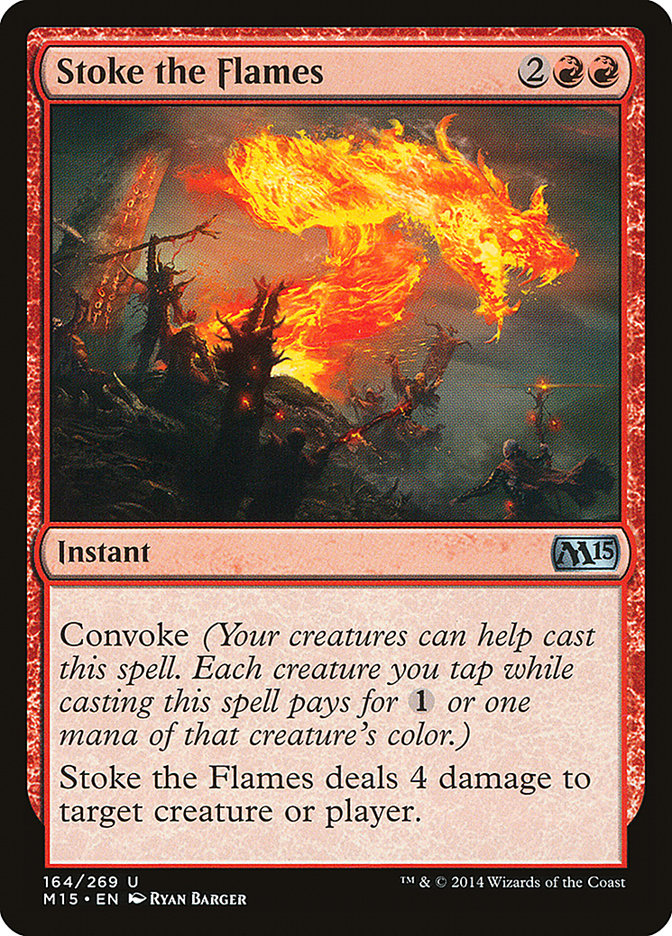
How many four-drop burn spells can we run in Burn? This is a real dilemma. It’s tempting to be excited about a package like this:




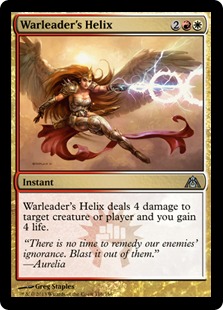



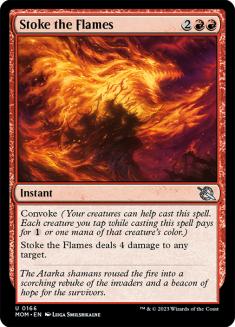



Of course, the problem comes into paradise when you find yourself with three or four four-mana spells in your hand and you realize you can’t cast everything. While I’m not a huge fan of Shock, one of the things that seems like it is more apparent is that if you have enough high-impact burn spells in your Burn deck, even the lowly Shock can help find a way to end the game more often than it does in the current deck.
One of the small concessions that the deck has been making to its mana is the inclusion of Mana Confluence. It’s a powerful card, to be sure, but it’s also problematic in a race. Thankfully, the deck has a near-perfect upgrade in the reprint of Battlefield Forge. I say “near perfect” because Mana Confluence does help the “Toil” portion of Toil//Trouble, if you play that card, and that isn’t meaningless.

Just being able to skip a little bit of damage is going to be a big deal. At worst, Battlefield Forge will deal as much damage to you as Mana Confluence. However, there are a great deal of colorless mana symbols in this deck.
Finally, while I’m not sure they have a place, there are two cards that are otherwise spoiled that seem intriguing.
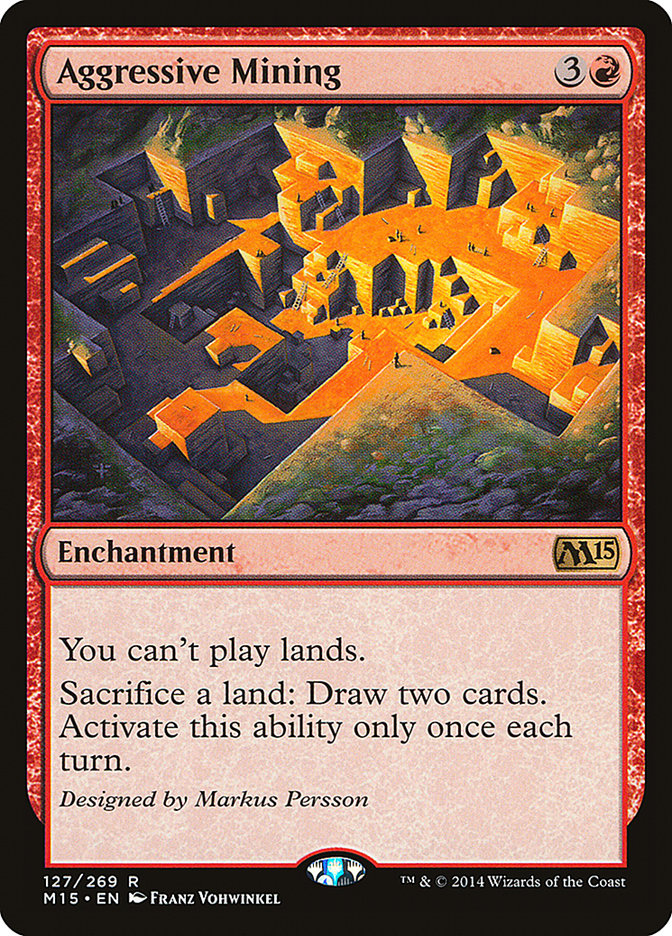
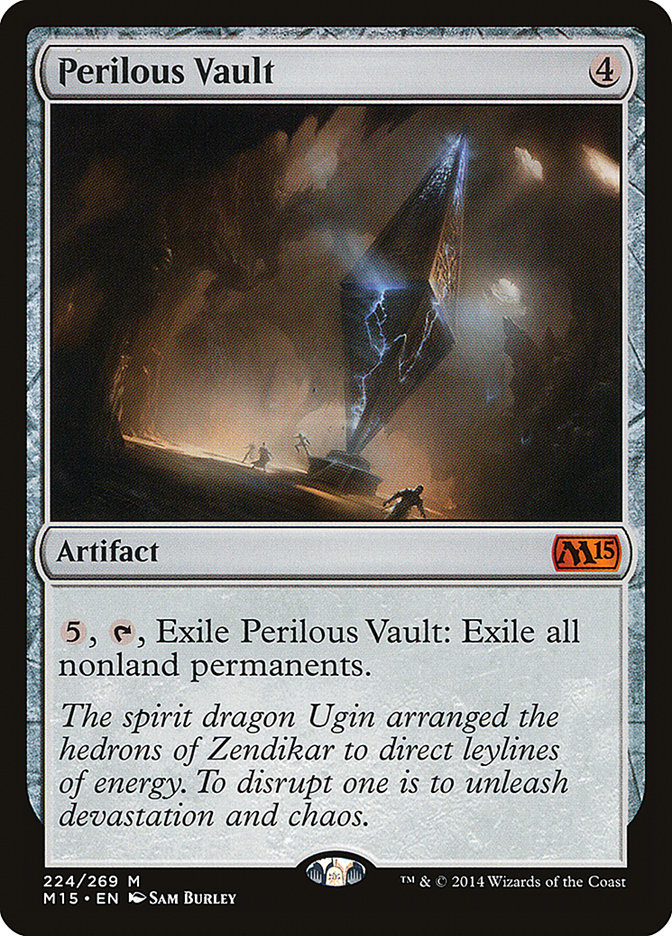
Aggressive Mining seems like an incredibly frightening card draw engine in a very late game for this deck. At the same time, you often want some of those lands if you’re going to a very late game, as you’re often just holding up mana doing nothing against a control deck, staring each other in the eyes, waiting for the other to make a move. Perilous Vault, though expensive, seems like a potentially fabulous answer to all kinds of problems. While Chained to the Rocks is infinitely cheaper, it is easy to imagine taking a single hit from whatever, and then untapping with the ability to clear the board. I’m not certain that Perilous Vault is what this deck needs (though if Nevinyrral’s Disk existed, I’m confident it would be in the deck/sideboard of Burn today), but it is certainly worth considering.
All of that being said, here is my speculative build of M15 Burn:
4 Young Pyromancer
4 Chandra’s Phoenix
4 Lightning Strike
4 Magma Jet
4 Skullcrack
4 Boros Charm
4 Warleader’s Helix
3 Searing Blood
2 Stoke the Flames
3 Shock
1 Harness by Force
4 Mutavault
7 Mountain
1 Temple of Malice
3 Battlefield Forge
4 Sacred Foundry
4 Temple of Triumph
Sideboard:
1 Chandra, Pyromaster
1 Aggressive Mining
2 Toil
1 Perilous Vault
1 Tajic, Blade of the Legion
1 Harness by Force
2 Glare of Heresy
3 Mizzium Mortars
3 Chained to the Rocks
A part of me just wants to go bonkers and drop all of the Chained to the Rocks in favor of three more Perilous Vault, though if I did that, I think I’d need a 24th land in the deck (probably a second Temple of Malice). This might just be me going overboard. Patrick Sullivan once said he views my deckbuilding as me taking a concept and pushing it to the very edge of what it can do; this might be that.
All told, though, I really like this deck a lot. If I wasn’t so gung-ho about U/W Control right now, I’d likely be playing this. Or, if not Burn, then I’d probably be playing the R/w Aggro deck that I took to the semis of SCG Milwaukee late last year.
Since I brought up how I have Burn ready in all formats, here are my other Burn decks right now, for your viewing pleasure:
Creatures (11)
Lands (20)
Spells (29)

Creatures (23)
- 2 Grim Lavamancer
- 4 Keldon Marauders
- 1 Simian Spirit Guide
- 4 Goblin Guide
- 4 Vexing Devil
- 4 Ghor-Clan Rampager
- 4 Eidolon of the Great Revel
Lands (20)
Spells (17)
Sideboard

I’m not in love with either of these decks, but I’m certainly in deep like. Perhaps something will emerge from M15 which will make me wildly endorse them, but right now, I can only say that I think they are good enough to consider playing in an event you want to win, not good enough that you definitely ought to play them.
Hall of Fame
It’s that time of year again. Hall of Fame time.
On July 2nd, I got my ballot, and I had to start to think deeply about who I might choose for the Hall of Fame. I’ve been on the Selection Committee for a long time now, since the second ballot, way back in 2006. In that time, I’ve voted for a lot of people; some of them have made the Hall of Fame, and some of them have not. That’s just the way that these things go. Personally, I view it as a great honor to be able to vote for these incredible players, and I take who I select very seriously.
Of course, everyone has a different idea of what the Hall of Fame means. This is actually a good thing, though. The Hall of Fame doesn’t belong to any one person, and the amalgamation of all of our very different concepts of what makes the Hall of Fame the Hall of Fame is a part of this. Hopefully, so long as everyone takes their job seriously, the people we vote into the Hall of Fame will be a fairly good representation of the right people. Now, I have my frustrations with things that have happened in the history of the Hall of Fame (the merging of the Player’s Committee with the Selection Committee is a minor one, but this is largely based on the nepotistic history of PC votes), but overall, I think it is a grand thing.
For me, my goal is to keep the Hall of Fame a revered and hallowed place, and so my lines of voting might be more strict than some others. For me, for example, I have a few baselines for voting for someone that they have to cross:
- Never banned from the game
- At least one major title (PT Champ, National Champ, Masters Champ, Player of the Year, Rookie of the Year, Worlds Team Champ)
- At least one Pro Tour Top 8
This year’s ballot is full of 39 incredible players:
Nico Bohny
Marcio Carvalho
Andrew Cuneo
Willy Edel
Gerard Fabiano
Ivan Floch
Eric Froehlich
Justin Gary
Mark Herberholz
Richard Hoaen
Tsuyoshi Ikeda
Michael Jacob
Scott Johns
Robert Jurkovic
Martin Juza
Tomohiro Kaji
Tzu-Ching Kuo
Shingou Kurihara
Osyp Lebedowicz
Marijn Lybaert
Tom Martell
Makihito Mihara
Katsuhiro Mori
Andre Mueller
Kenny Oberg
David Ochoa
Jamie Parke
Brock Parker
Paul Rietzl
Tomoharu Saito
Terry Soh
Yuuta Takahashi
Gerry Thompson
Robert van Medevoort
Guillaume Wafo-tapa
Craig Wescoe
Shouta Yasooka
Adam Yurchick
Matej Zatlkaj
After applying my filters, though, this list reduces quite remarkably to these nine players (from least PT Points to most):
Tomohiro Kaji
Brock Parker
Tom Martell
Osyp Lebedowicz
Willy Edel
Justin Gary
Paul Rietzl
Makahito Mihara
Shouta Yasooka
In looking at their respective resumes, it became clear that there were two people who, to me, felt like locks.
Shouta Yasooka is a Pro Tour Champion as well as a Player of the Year winner. He has also won a Grand Prix, and has what I might call “The Alex Shvartsman Award” – having double the number of Grand Prix Top 8 of the next leading player on the list, with 18 Top 8s (Paul Rietzl has 9). He is an incredible competitor, and one of the most talented deckbuilders the world has ever seen. His resume is definitely Hall of Fame worthy.
The other lock for me is a player I’ve been voting for years: Justin Gary. I’ve already written a longer explanation of why I think Justin Gary is a lock for the Hall of Fame, and I heartily recommend that you read it. Here are the highlights: three Pro Tour Top 8s, plus a win in Houston. Two US Nationals Top 8s, twice on the National team, once the US National Champion, One Worlds Team Championship, a Grand Prix win, a Masters finalist, and one of the highest peak performances in the games history (averaging 25th place at the Pro Tour during his three-year peak). Go read my full write-up on Justin and I think you’ll agree he is one of the strongest choices on this year’s ballot.
This leaves me three slots to vote for and eight people to consider for them. I’m already digging into their stats, but I haven’t come to any conclusions yet. I’m certainly very willing to discuss this with anyone. I know that come the time to turn in our ballots, I’ll have considered every one of these players, listened to everyone who has a reasoned opinion, and probably discussed it endlessly.
And that’s the way it should be.
Happy Fourth of July, everyone.
